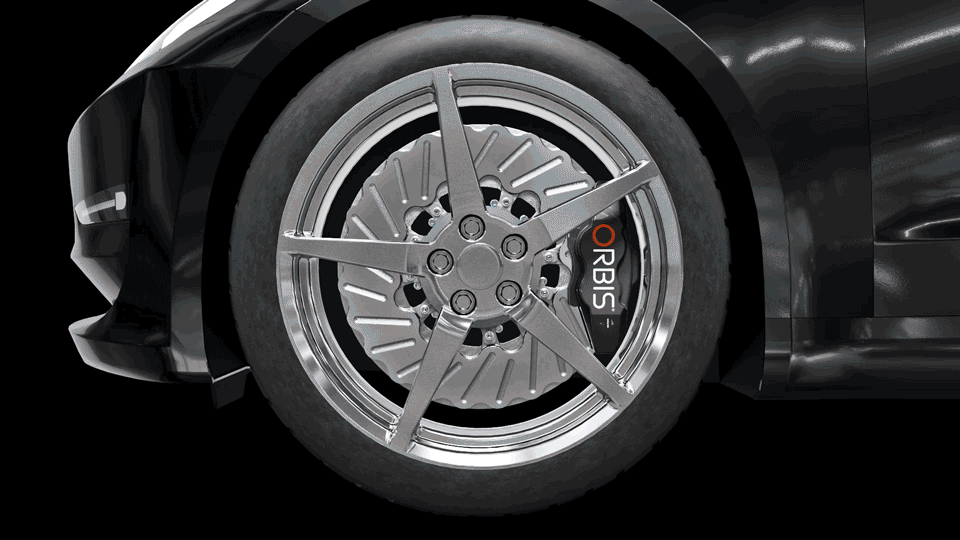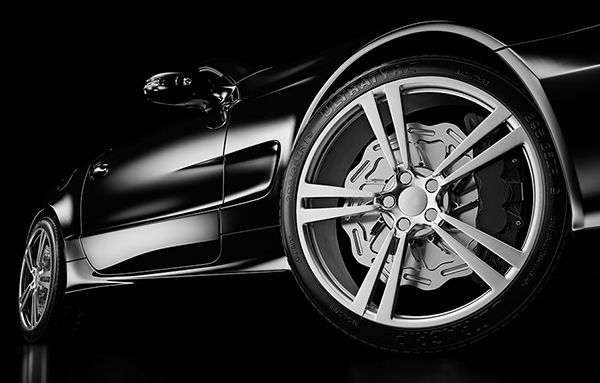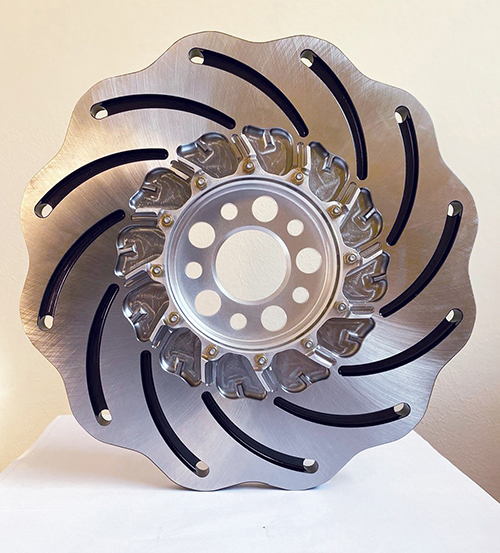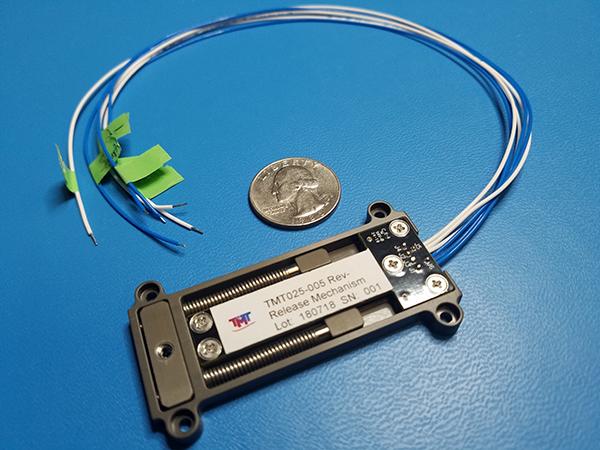
NASA Gives the World a Brake
Subheadline
Space agency invention puts a new spin on automotive brake rotors
Just as NASA needs to reduce mass on a spacecraft so it can escape Earth’s gravity, automotive manufacturers work to reduce weight to improve vehicle performance. In the case of brake rotors, lighter is better for a vehicle’s acceleration, reliable stopping, and even gas mileage. Orbis Brakes Inc. licensed a NASA-patented technology to accomplish that and more. This revolutionary brake disc design is at least 42% lighter than conventional cast iron rotors, with performance comparable to much more expensive carbon-ceramic brakes.
During the pandemic shutdown, Jonathan Lee, structural materials engineer at NASA’s Marshall Space Flight Center in Huntsville, Alabama, got to thinking about disc brakes. His skills as a mechanical designer backed with material science training are usually focused on his dual roles as the structural materials engineer for the Space Launch System and a microgravity material scientist for the space station. Interested in supporting NASA’s other mission to advance technology to improve life on Earth, he was looking for an innovative way to design a better automobile disc brake.
“NASA’s willingness to help companies be more successful, using all of their expertise and the goodwill that extends, is really amazing,” said Chance Claxton, co-CEO of Santa Rosa, California-based Orbis Brakes.
The Periodic Wave
Reducing the mass of its wheels means a vehicle will use less energy to brake and accelerate. Conventional brake discs are heavy because they consist of two metal plates cooled by air circulating between them. The design is inefficient because it’s the outside surfaces that are heated by friction with the brake pads, but the air cooling takes place on the inside surfaces, where the plates face each other. Lee wanted to directly cool the hot surfaces instead, allowing one of the heavy discs to be eliminated from each of a vehicle’s four rotors. His design proved to have additional benefits as well.
He started with a single disc with a series of small fins around the central hub. As they spin, these draw in air and push it across the surface of the disc, where the brake pads make contact, cooling the rotor, as well as the brake pads and calipers. He then added several long depressions around the braking surfaces, radiating from the center to create the regular, periodic pattern that gives the new Orbis technology its PeriodicWave brand name.
The spinning fins and the centrifugal force of the wheel push air into the depressions, causing a turbulent airflow that draws away heat. “When the air flings out, it goes across the brake caliper and cools it – no conventional rotor is capable of doing something crazy like that. It’s huge,” said Lee.
These trenches in the braking surfaces also increase the available surface for air cooling by more than 30% and further reduce the weight of the disc. And they increase friction in the same way that scoring concrete makes steps safer to walk on – the brake pads are less likely to slip, which makes braking more reliable.
The troughs draw away more than just heat, too. Water and road debris getting between the pad and rotor are equally problematic, so the trenches provide a place for the air vortex to push any substance out of the way. A small hole machined at the end of each one creates an opening through which unwanted material can escape. “And it also just looks cool,” said Lee.
A second periodic wave is cut along the outer edge of the disc. By replacing the conventional circular design with an undulating pattern, the new rotor has still more surface area that will come into contact with the cool air flowing over it. This additional heat dissipation will occur no matter which periodic wave pattern is used, making it possible to create funky designs and add personality to what is usually a boring car part.
Finally, a thin layer of black coating applied to surfaces that don’t come into contact with the brake pads, like the inside of the troughs, can help the rotor to radiate additional heat. This unique three-part cooling system – convection powered by airflow, conduction of heat across the metal rotor, and radiation from dark-coated surfaces – has never been implemented effectively on any conventional disc brake rotor before, Lee said.
Eco-Friendly Brakes
Unlike conventional brakes that can overheat and potentially fail, this new brake design can dramatically improve dependability. It also may offer a mechanical solution to a serious environmental pollutant – toxic nanoparticles.
“When brake pads exceed a certain critical temperature, depending on their materials, they can emit a 10,000-fold increase in toxic nanoparticulates,” said Marcus Hays, co-CEO of Orbis Brakes. Because the toxic dust hovers right at street height, the impact on human health is more harmful than exhaust emissions, according to an Oxford University study. So the company is currently testing its EcoWave brake design to ensure it will not create that kind of emission, according to Hays.
In the meantime, Orbis is offering the NextWave rotor as an after-market disc brake for high-performance cars like the Ford Mustang and some Tesla models.
Electric cars can be about 25% heavier than internal combustion-engine vehicles, and they have excellent speed, acceleration, and torque. Owners tend to drive them like sports cars, according to Hays, so the company is offering an alternative to the factory-installed brakes, which aren’t designed for that kind of handling. NextWave will enable faster stops and better direction changes, in addition to a different kind of cool factor: “This extraordinary functional configuration also has an incredibly novel appearance – there’s nothing like it in the history of disc brakes,” said Claxton.
‘Mind-Blowingly Powerful’
As the company gets feedback from early adopters, it will be preparing two more lines: LightWave will combine the NextWave rotor with a lightweight caliper, and CarbonWave will be exclusively for electric vehicles.
All of these models weigh approximately half what conventional rotors weigh, while drastically improving the braking performance. All the brakes will be manufactured in the United States. In addition to the potential for reduction of toxic nanoparticles, the carbon footprint for every type of periodic wave disc brake will be much smaller than conventional brakes.
Calling NASA’s Technology Transfer program “instrumental to American competitiveness,” Hays described the company’s relationship with NASA as “mind-blowingly powerful.”
“It is absolutely going to catapult our business and gives us a credibility and validity for everything we do,” he said. “NASA gives us a foundation to go out into the world and negotiate and have the respect of our peers right out of the gate. That would not be the usual case for an early-stage company.”

The periodic wave design of the Orbis Brakes NextWave disc brake reduces the overall weight by about 40% while increasing surface area and incorporating more efficient cooling to prevent overheating, and it reduces the release of brake pad particulate matter into the environment Credit: Orbis Brakes Inc.

Materials used in space must survive extreme temperatures, as demonstrated by this static test of a booster engine for the Space Launch System. NASA’s materials experience helped Orbis Brakes create a new, lighter, affordable disc brake system for cars and trucks. Credit: Northrop Grumman Corp.

Early adopters of the Orbis Brakes NextWave disc brake for high-performance cars include the personal vehicles of race car drivers who provide the company feedback about performance. The input will inform the design of future brakes for electric cars, gas combustion-engine vehicles, and everyday drivers. Credit: Orbis Brakes Inc.

Current brake system technology cool disc brakes with air pulled from inside the vehicle’s body to prevent overheating. The channels cut into the exterior of the disc brakes developed by Orbis Brakes draw in external air, which is cooler, ensure the brakes work more efficiently. Credit: Orbis Brakes Inc.













